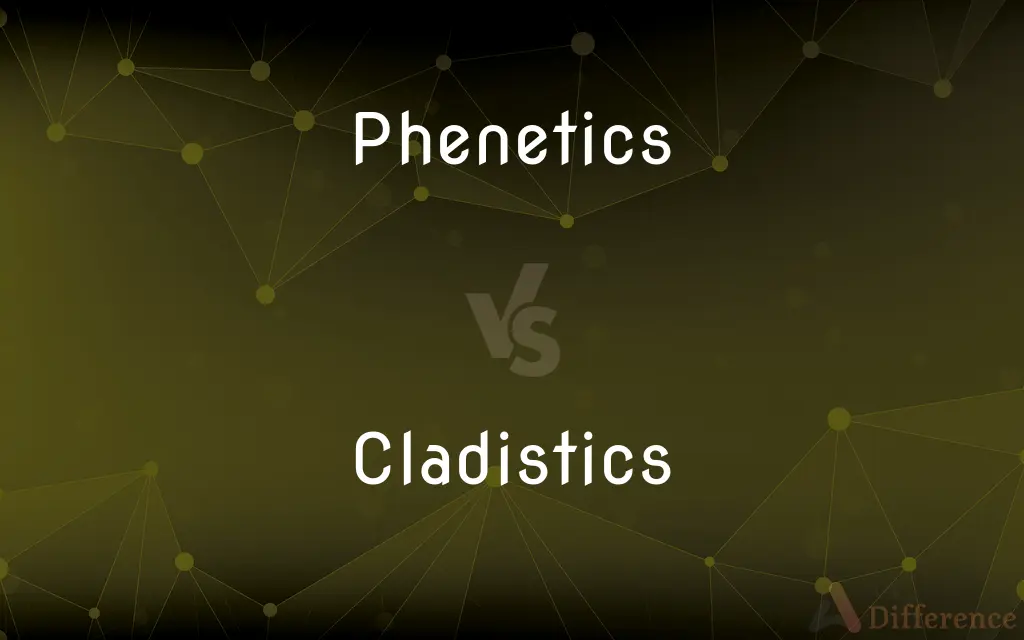Phenetics vs. Cladistics — What's the Difference?
Edited by Tayyaba Rehman — By Maham Liaqat — Published on February 25, 2024
Phenetics focuses on quantifying overall similarities among organisms, while cladistics classifies them based on shared derived characteristics, highlighting evolutionary relationships.

Difference Between Phenetics and Cladistics
Table of Contents
ADVERTISEMENT
Key Differences
Phenetics, also known as numerical taxonomy, involves the classification of organisms based on measurable traits, aiming for an objective overview of similarities and differences. It uses algorithms to analyze multiple traits and produce a phenogram that represents these similarities without considering evolutionary pathways.
Cladistics, or phylogenetic systematics, prioritizes evolutionary relationships, classifying organisms into clades based on common ancestry. This method relies on the concept of shared derived characteristics (synapomorphies) to construct a phylogenetic tree, illustrating how species diverge from common ancestors.
Phenetics employs a broad comparison of traits, while cladistics is more focused, distinguishing between ancestral (plesiomorphic) and derived (apomorphic) traits to infer lineage. This distinction underpins the fundamental difference in approach: phenetics for overall similarity, cladistics for evolutionary history.
The output of phenetic analysis, a phenogram, visually represents the degree of similarity among species, whereas cladistics produces a cladogram that reflects the hypothesized evolutionary relationships and branching order among groups.
Despite their differences, both methods serve crucial roles in biological classification and biodiversity studies. Phenetics can provide a preliminary overview useful for identifying patterns of similarity, while cladistics offers deeper insights into the evolutionary history and relationships among organisms.
ADVERTISEMENT
Comparison Chart
Basis of Classification
Overall similarity based on measurable traits
Shared derived characteristics indicating common ancestry
Objective
To quantify and visualize the degree of overall similarity
To elucidate evolutionary relationships and lineage
Methodology
Uses algorithms to analyze trait data, producing a phenogram
Identifies synapomorphies to construct a cladogram
Focus
Broad comparison of traits without regard to evolutionary history
Evolutionary history and distinction between ancestral and derived traits
Outcome
Phenogram representing similarity levels
Cladogram depicting hypothesized evolutionary relationships
Compare with Definitions
Phenetics
It employs quantitative methods to analyze traits.
Measuring the number of scales on fish to determine their phenetic relationships.
Cladistics
Cladistics classifies organisms based on common ancestry.
Humans and chimpanzees are placed in a clade due to shared derived traits.
Phenetics
Phenetics is the classification of organisms based on overall similarities.
Frogs and salamanders are grouped together due to similar morphological traits.
Cladistics
It focuses on shared derived characteristics (synapomorphies).
The presence of feathers is a synapomorphy identifying the bird clade.
Phenetics
Phenetics generates a phenogram to represent similarities.
A phenogram shows birds and dinosaurs closely grouped based on shared physical traits.
Cladistics
Cladistics produces a cladogram.
A cladogram illustrates the evolutionary split between amphibians and reptiles.
Phenetics
Phenetics uses multivariate statistics.
Principal component analysis is used to distinguish among plant species.
Cladistics
It distinguishes between ancestral and derived traits.
Cladistics considers the amniotic egg a derived trait unique to amniotes.
Phenetics
It does not prioritize evolutionary relationships.
Phenetics might group bats with birds rather than with mammals based on wing structures.
Cladistics
Cladistics helps reconstruct evolutionary history.
Analyzing DNA sequences to infer the evolutionary history of mammals.
Common Curiosities
What is a cladogram?
A diagram that shows the hypothesized evolutionary relationships among groups of organisms, based on cladistics.
What is a phenogram?
A visual representation of the similarity among organisms, generated through phenetic analysis.
What is the main goal of phenetics?
To quantify and visualize overall similarity among organisms.
What are synapomorphies?
Shared derived characteristics used in cladistics to infer common ancestry.
Can cladistics predict evolutionary pathways?
Cladistics can hypothesize about evolutionary pathways based on the analysis of derived characteristics and cladogram structure.
How does cladistics differ from phenetics in classifying organisms?
Cladistics focuses on evolutionary relationships based on shared derived characteristics, unlike phenetics, which is based on overall similarity.
Can phenetics and cladistics be used together?
Yes, they can complement each other in understanding organism relationships, with phenetics providing a broad similarity overview and cladistics offering detailed evolutionary insights.
How does cladistics identify evolutionary relationships?
By analyzing shared derived traits among organisms to construct a cladogram.
How does phenetics handle genetic data?
Phenetics can include genetic data as part of the measurable traits for analysis.
Can phenetics accurately reflect evolutionary relationships?
Phenetics primarily reflects overall similarity, which may not always correspond to evolutionary relationships.
Is phenetic classification subjective?
While it aims for objectivity by quantifying traits, the selection of traits can introduce subjectivity.
What is the significance of distinguishing between ancestral and derived traits in cladistics?
It helps in understanding evolutionary changes and the divergence of lineages.
Why is cladistics preferred for phylogenetic analysis?
Due to its focus on shared derived characteristics and the ability to more accurately reflect evolutionary history.
Are phenograms and cladograms interpreted differently?
Yes, phenograms focus on similarity levels, while cladograms depict evolutionary relationships and divergence.
How does cladistics contribute to evolutionary biology?
It provides a methodological framework for reconstructing the evolutionary history and relationships among organisms.
Share Your Discovery

Previous Comparison
Daycare vs. Preschool
Next Comparison
Stain vs. PaintAuthor Spotlight
Written by
Maham LiaqatEdited by
Tayyaba RehmanTayyaba Rehman is a distinguished writer, currently serving as a primary contributor to askdifference.com. As a researcher in semantics and etymology, Tayyaba's passion for the complexity of languages and their distinctions has found a perfect home on the platform. Tayyaba delves into the intricacies of language, distinguishing between commonly confused words and phrases, thereby providing clarity for readers worldwide.














































